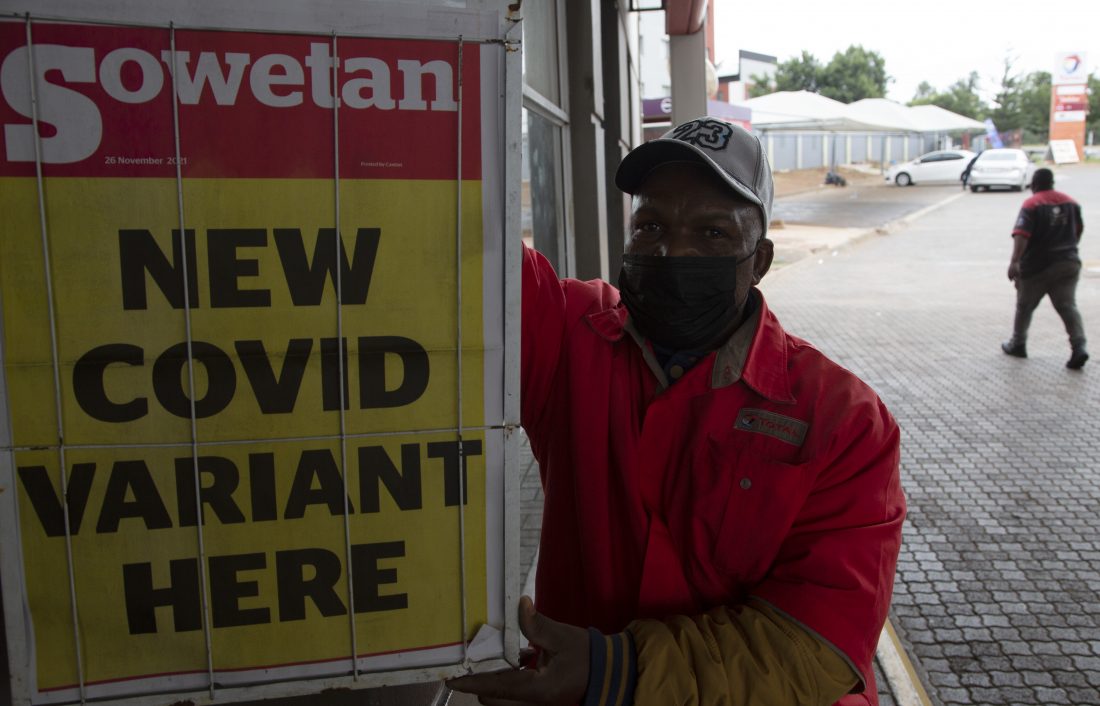State lab can detect omicron variant
Nasal swab tests show partial false positive result

AP PHOTO A petrol attendant stands next to a newspaper headline in Pretoria, South Africa, Saturday. As the world grapples with the emergence of the new variant of COVID-19, scientists in South Africa — where omicron was first identified — are scrambling to combat its spread across the country.
The latest significant coronavirus variant — dubbed “omicron” by the World Health Organization on Friday — has several troubling mutations that might boost its ability to spread, but the changes also make it more quickly detectable by the State Hygienic Laboratory, which processes the tests of Iowa residents.
“Fortunately for us, the (tests) that we mostly use would pick up this very unusual variant that has a real large constellation of mutations,” Dr. Anthony Fauci, director of the National Institute of Allergy and Infectious Diseases, said Monday.
The variant was first identified last week in South Africa amid a steeply increasing infection rate in the country and was quickly labeled a “variant of concern” by the WHO. It will be weeks before health officials can say with confidence whether omicron is more dangerous than previously identified variants or if current vaccines will provide less protection against it.
But omicron also causes a false negative result for part of the common nasal-swab tests for the virus, according to the WHO. That can be used as a preliminary indicator of the variant, but the State Hygienic Laboratory must do further genetic sequencing to definitively identify it, according to the Iowa Department of Public Health.
President Joe Biden has halted travel to the United States from several countries near the southern tip of Africa in an attempt to slow the variant’s spread. On Monday morning, he urged people to get vaccinated and to wear masks indoors in public places.
“Sooner or later we’re going to see cases of this new variant here in the United States,” he said. “This variant is a cause for concern, not a cause for panic.”
The first omicron infection was confirmed from a test on Nov. 9, the WHO reported. The variant has recently been detected in many European countries, Australia and Canada.
“It may already be here, who knows,” said Pramod Dwivedi, the public health director for Linn County in Cedar Rapids. “Our message to our neighbors remains the same: It is a dangerous virus we are dealing with, and we need to be using every tool in our toolbox to beat the virus.”
The Iowa Department of Public Health is waiting for more details about omicron’s severity and transmissibility before it alters its guidance for county health officials and residents, said Sarah Ekstrand, an IDPH spokesperson. On Monday, she echoed Biden’s remarks from earlier in the day: “Get vaccinated as soon as possible.”
About 56 percent of all Iowans are fully vaccinated, according to the U.S. Centers for Disease Control and Prevention, which advised all adults on Monday to get vaccine booster shots. Less than a third of vaccinated Iowans have received a booster dose.
Fully vaccinated residents have accounted for an increased share of those who receive in-patient treatment at hospitals after being infected by the coronavirus, but unvaccinated residents are still far more likely to require hospitalization. About 75 percent of COVID-19 patients are unvaccinated in Iowa, and the group accounts for about 86 percent of those who require intensive care, according to state data.
The state’s infection rate has been increasing for weeks, and the number of COVID-19 patients in hospitals reached a new high for the year at 665 on Sunday.
“If you are not vaccinated, you need to get vaccinated,” said Nola Aigner Davis, spokesperson for the Polk County Health Department.






